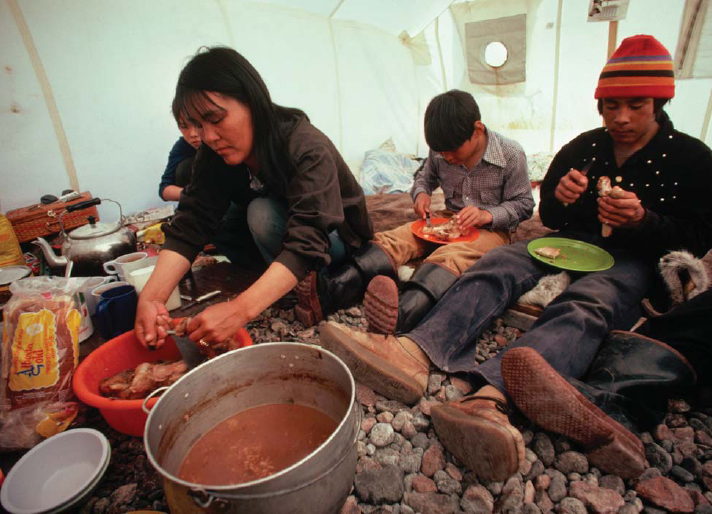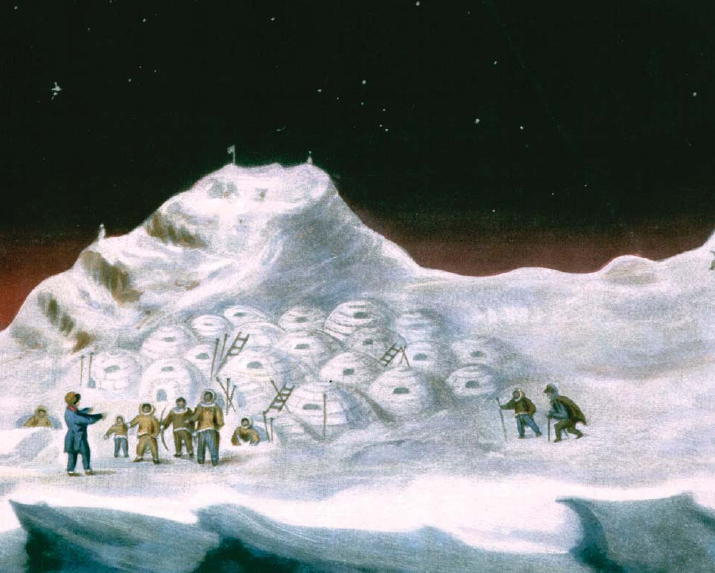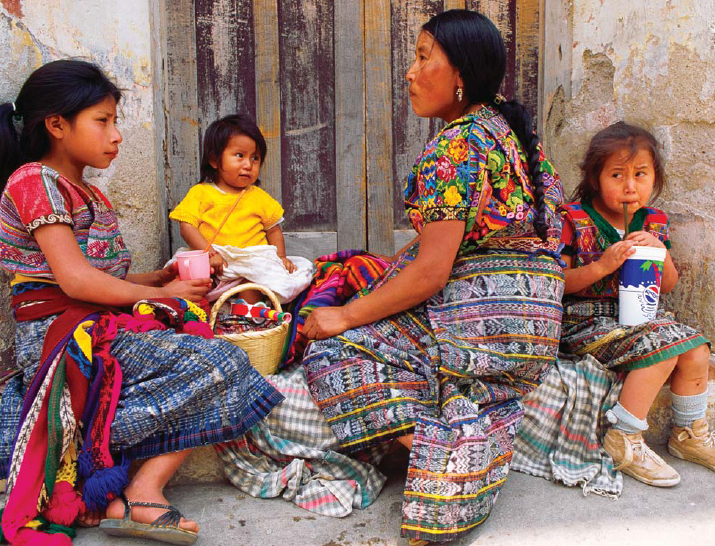
Members of an Inuit family sit down together for a meal. Traditionally, the Inuit maintained close relationships with both immediate and extended family members.
5 Families of Abundance and Subsistence
The Native Americans who lived in what today are the northwestern United States and Canada had very diverse lifestyles. The Northwest was a land of abundance. The people living here did not have to work as hard as the natives living in the far north. The Arctic and subarctic regions, on the other hand, were areas in which farming was impossible and survival was difficult.
Traditionally, bilateral extended families formed the basis of most Arctic Inuit societies. Although Inuit society was primarily arranged around the nuclear family, the Inuits also maintained close relationships with their extended family members.
Nuclear and extended families often lived together. If they did not share the same winter sod home or summer caribou-skin tent, they often lived close to one another in small communities. Individual survival in the Arctic regions was dependent upon the cooperative contributions of all family members, especially during whaling season.
Above all else, Inuit men needed to be hunters and fishermen of the highest quality. Life in the Arctic depended upon stockpiling foods such as whale, seal, caribou, and arctic char. In coastal whaling villages, whaling captains were highly respected and admired. In villages that did not whale, the best hunters were held in high regard. Respected and admired above all Inuit men, however, was the family shaman.
Women of the northwestern tribes were well known for the watertight baskets they wove from grasses and plants, as well as their for beautifully decorated wooden boxes. The boxes were so finely fitted together that they could be used to cook food. Very hot rocks were put into the box around or under the food. The box was then closed and the food was left to cook in this small wooden oven. The tighter the box was fit together, the more heat it would hold in and the better it would cook food.
The Inuit shaman possessed a gift for contacting spirits. He was also a wise man, able to instruct his people in times of trouble. The Inuit shaman was a healer and teacher who had great knowledge of humans, animals, and the spirits. A good shaman knew many herbal remedies and other types of treatments for illnesses.

Members of an Inuit family sit down together for a meal. Traditionally, the Inuit maintained close relationships with both immediate and extended family members.
Inuit women of the Arctic were mothers, wives, homemakers, and gatherers. They kept track of the family food supplies. They sewed fine fur parkas to keep their husbands and children warm. They sewed seal-and walrus-gut raincoats to keep their husbands and sons dry during whale and seal hunting season. They collected salmonberries and other edible tundra plants in the late spring, summer, and early fall.

This painting of Inuit snow cottages, also called igloos, was made around 1834 by a man who had sailed with Captain James Ross’s polar expedition. Ross was a 19th century English explorer who traveled to both the Arctic and Antarctic regions. After returning from the Arctic in 1833, he described how the Inuit people he met lived.
Inuit children were often adopted out of large families and into smaller ones. This was done so that they would receive the amount of food, shelter, attention, and clothing necessary for survival in the harsh environment of their homeland. Children who were adopted into another family often grew up knowing both sets of parents. As this was an accepted and understood practice, they did not feel ashamed or unwanted because of their adopted status.
An Inuit girl who was fully grown exchanged the clothes of her childhood for those of an adult woman. In some Inuit groups, she was also tattooed to mark her status as an adult. Inuit boys also changed their style of dress when they became recognized as grown men.
When an Inuit boy was deemed ready for marriage, two slits were cut in his cheeks or near the corners of his mouth. Ivory or bone cheek or lip plugs were placed in the openings. These cheek plugs visually announced to all that the boy was now a man, eligible for marriage.
Another people of the Arctic were the Aleut, who lived in the far northwest. The Aleut traced their family relatives through their mother’s family bloodlines. Aleut society had hereditary classes of high nobles, commoners, and slaves. The leaders were recruited from the high nobles’ class. They lived in communal homes called barabaras.
GAMES OF THE NORTH
Native American children who lived in the Far North and Northwest played a variety of games. In some areas of the Arctic children played a game called “polar bear.” One child pretended to be a sleeping old lady. Another pretended to be her sleeping child. The “polar bear” snuck up to them and took away the sleeping child. The “child” had to hide wherever the “polar bear” put him or her. The “old lady” was then awakened and had to search for her child.
Inuit kick-ball was played with a stuffed ball made from caribou or other animal skin. Two teams opposed each other and tried to maintain control of the ball. There were no goals like in soccer, but the game resembled modern-day soccer in many other ways.
Story telling was another form of Inuit entertainment. At night, when the family was safe inside their home, a father would entertain his children and wife with tales from his life or the lives of his ancestors. During this special family time, he would share stories that taught his children the history of their people, the values of their culture, and the teachings of their religion.
Northwest boys competed against each other in foot races, archery contests, and wrestling matches. The girls played with carved wooden dolls. Both girls and boys swam and played on the beaches.
In comparison to the subsistence families of these other regions, the people of the Northwest lived in relative splendor.
The Northwest Haida were divided into two phratries: the Raven and the Eagle. Each of these was divided into a large number of clans. One or more clans formed a village. Haida clans were matrilineal.
Boys and girls alike played a game much like modern-day horseshoes. Stakes were driven into the ground at opposite ends of a playing field. The players tossed roots at these stakes and tried to see who could land their root closest to the stake.
Families in the subarctic culture region played a game that was similar to the shell game. Players would each be given an equal number of tokens or markers of some sort. A player would take one token and then with both hands out of his or her opponent’s view, place it in one hand. Now, he or she would display two clenched fists. The opponent would guess in which hand the token was being held. If he or she guessed correctly, the prize was the marker. When one player ran out of markers, the other player was declared the winner.
Young Sanpoil girls of the plateau area played with dolls. They made these dolls by sticking clay balls atop sticks and wrapping them in bits of animal skin. The boys played with tops that were made from available local hardwoods. Sanpoil girls and boys turned somersaults, practiced walking on their hands, and did handstands. Their parents liked to play gambling games. Entire families enjoyed playing several games of skill that used hoops and poles.
Haida men’s titles and wealth were inherited through the mother’s side of the family. Men, however, owned the houses in Haida society. The fathers’ clans built these wooden-plank longhouses. When a man died, his sister’s eldest son inherited his house.
Haida clan chiefs were men. All of the clan chiefs of a village would be members of a council. The wealthiest clan chief was recognized as the village chief.
Haida marriages were often arranged. The two parties who were to be married had to be from different clans. They also were expected to be from the same social class. Sometimes, marriages were arranged when the husband- and wife-to-be were still small children. Unless one of the two children disgraced themselves or their families, they would usually be married to their arranged spouse when they came of age.
If a Haida man neglected or abused his wife, her parents had the right to take her and their grandchildren away from him. If he left his wife for another woman, then he was forced to pay reparations to his first wife. If he refused, he was punished severely, sometimes by death. However, if there was no other woman involved, a Haida man could leave his wife and family without fear of retribution.
Another tribe of the Northwest was the Cayuse. In this tribe men and boys hunted for food and to provide hides for clothing. They also provided their people with animal bones and antlers for making tools and utensils. Elk, deer, bear, antelope, and mountain sheep were hunted across their north-central North American homeland. The Cayuse men were accomplished hunters who learned to be comfortable hunting with bows, spears, knives, nets, and traps. Cayuse men also fished for salmon. This was often done from shore, using long-handled dip nets. The nets were used to reach out into the rushing streams and capture salmon that were swimming upstream to spawn.
Cayuse women cleaned salmon and hung them on long racks to dry in the sun. They dug for roots using wooden or bone digging tools. They mashed roots together and shaped them into little balls to make small sun-dried biscuits. When there was time, the Cayuse women took their children into the mountains to go berry picking. There they would pick huckleberries for drying. They also picked chokecherries to mix with dried meat or fish to make pemmican.
Children of the Salish tribe, which lived on the coast of North America, spent a lot of time with their grandparents while their parents were hunting, fishing, or gathering food. In fact, grandparents were the primary teachers. They taught family history, as well as the qualities and skills the young Salish children would need to be a good member of their society. §

The members of this family are Maya Indians of Central America. Around 1,600 years ago, their ancestors established a highly evolved society in Mexico and Central America. Today Mayan families still follow some of the same practices of the ancient Maya.